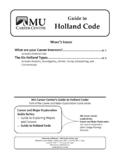Transcription of RESEARCH REPORT 148 - Health and Safety Executive
1 HSE Health & Safety Executive The case for CDM: better safer design a pilot study Prepared by Greenstreet Berman Ltd for the Health and Safety Executive 2003 RESEARCH REPORT 148 HSE Health & Safety Executive The case for CDM: better safer design a pilot study Michael Wright, Mark Bendig Greenstreet Berman Ltd First Base Gillette Way Reading Berkshire RG2 0BP Trevor Pavitt, Alistair Gibb Loughborough University Department of Civil and Building Engineering Leicestershire LE11 3TU The construction sector remains one of the highest risk sectors in the UK. Previous RESEARCH has concluded that there is concern in the construction industry that there has been limited success in securing safer designs. It is reported that The opportunities to design out hazards are not being exploited to the full . Surveys have also reported that designers are not always fully aware of how they can reduce construction hazards by changing the design of structures.
2 This project identified simple examples of how designers have significantly improved construction Safety and reduced costs / programme time. These examples are illustrated, and hence can be used to raise awareness of how designers can achieve better, safer and cheaper construction. The case studies show that the main factor in achieving safer design is forethought and an appreciation of buildability issues. The examples do not entail specialist technology. This REPORT and the work it describes were funded by the Health and Safety Executive (HSE). Its contents, including any opinions and/or conclusions expressed, are those of the authors alone and do not necessarily reflect HSE policy. HSE BOOKS Crown copyright 2003 First published 2003 ISBN 0 7176 2733 0 All rights reserved. No part of this publication may be reproduced, stored in a retrieval system, or transmitted in any form or by any means (electronic, mechanical, photocopying, recording or otherwise) without the prior written permission of the copyright owner.
3 Applications for reproduction should be made in writing to: Licensing Division, Her Majesty's Stationery Office, St Clements House, 2-16 Colegate, Norwich NR3 1BQ or by e-mail to ii CONTENTS 1 1 Background .. 1 Designers duties under 3 Examples of the impact of design .. 4 Aims of this project .. 5 Structure of this REPORT .. 6 2 METHOD .. 7 Overview .. 7 Method description .. 7 Case study selection criteria .. 7 Identify and screen examples .. 8 Collate 8 Drafting and piloting of materials .. 10 3 CASE 11 Introduction .. 11 Case study 1: Pre-installed windows and glazing within precast concrete cladding panels .. 12 Summary .. 12 Traditional method .. 13 Alternative method .. 13 Health and Safety benefits .. 14 Commercial 16 Case study 2: Pre-cast concrete guide-wall moulds .. 17 Summary .. 17 Traditional method .. 18 Alternative method.
4 21 Health and Safety benefits .. 24 Commercial 25 Case study 3: pre-cast concrete beams .. 27 Summary .. 27 Background .. 28 Traditional method .. 28 Alternative method .. 30 Health and Safety benefits .. 31 Commercial benefits .. 33 Case study 4: Structural steel columns- pre drilled web hole .. 34 Summary .. 34 Background .. 35 Traditional method .. 36 Alternative method .. 37 Health and Safety benefits .. 39 Commercial 40 Case study 5: Gutter/handrail support .. 41 Summary .. 41 Background .. 42 iii Traditional method .. 42 Alternative method .. 46 Health and Safety benefits .. 48 Commercial 49 Case study 6: Unitised curtain walling .. 50 Summary .. 50 Background .. 51 Traditional method .. 51 Alternative method .. 53 Health and Safety benefits .. 54 Commercial 57 Case study 7: Built up/ composite 59 Summary.
5 59 Background .. 60 Built up roof system .. 60 Composite Roof 61 Health and Safety comparison between 63 Commercial 65 Researcher s recommendations .. 66 4 68 REFERENCES .. 69 iv 1 INTRODUCTION Background The construction sector remains one of the highest risk sectors in the UK. A study1 conducted on behalf of the HSE (Construction Health and Safety for the new millennium) calculated the fatal and major injury rates for a selection of trades, as shown in Table 1. Taking a few examples it can be seen that; In a forty year career in scaffolding, you stand a 1 in 3 chance of a major injury and 1 in 130 chance of death! A steel erector has a 1 in 75 chance of death and a 1 in 6 chance of a major injury over a 40 year career! In both cases the main risk is of falls.
6 The latter study also found that the trades with the lower risk of fatal accidents, such as carpentry, tend to have a higher risk of serious ill Health , such as respiratory diseases, skin disease and hearing loss. The high incidence of musculoskeletal disorders associated with manual handling is well known. Injury rate data for the period following this study gives no reason to suppose the position has changed significantly. Table 1: Construction trade risk Trade Probabilityyear (1993 t of death per o 1998) Probabilityinjury (1996 of major -1998 Scaffolders 1 in 5,357 1 in 115 Roofers 1 in 3,764 1 in 300 Steel erectors 1in 3,016 1 in 232 Glaziers 1 in 11,956 1 in 360 Painters & floorers 1 in 19,000 1 in 522 Maintenance workers 1 in 23,000 1 in 300 General operatives 1 in 28,000 1 in 600 Electrical trades 1 in 52,000 1 in 600 Bricklayers 1 in 76,500 1 in 600 Carpenters 1 in 78,000 1 in 512 Plumbers 1 in 80,500 1in 990 All construction industry 1in 13,000 1 in 250 1 Construction Health and Safety for the new Millennium.)
7 Health and Safety Executive Contract RESEARCH REPORT 31/3/2000. 1 The latter RESEARCH also explored the role of designers in construction Health and Safety and the factors that influence uptake of Health and Safety by employers. The RESEARCH found that: The vast majority (~70%) of respondents believe it is possible to foresee and remove Health and Safety problems during the design stage; Only a minority (~25%) reporting that the division of tasks between designers and contractors make it difficult to manage Health and Safety (p31); Respondents believe designers have a large scope to improve Health and Safety (p 34) but that they do not necessarily give a high priority to Health and Safety ; About 30% of respondents (taking contractors, designers and client together) did not believe there had been any improvement in designed Safety , although 50% of designers tend to believe there has greater improvement in designed Safety .
8 The study concluded that there is concern in the construction industry that there has been limited success in securing safer designs. The opportunities to design out hazards are not being exploited to the full. (p70). It is also reported that there has only been some improvement in designers understanding of Health and Safety risks, which, whilst ahead of clients, lags behind other parties such as project managers. It is also feared that professional qualifications for designers do not prepare them for real Health and Safety issues. This concern is expressed by designers more so than contractors and clients. Indeed, respondents indicted that designers are not always aware of how they can help to reduce construction hazards by changing the design of structures. In particular: Designers have limited experience and understanding of buildability; The differences in risk levels experienced by different trades and work methods is not well understood; The relationship of Health and Safety issues to lifetime costs is not well understood; Risk assessment are often insufficient, and; Risk assessments are undertaken too late to bring about design changes, therefore the opportunity to consult with other members of the construction team at this point is often not taken.
9 Respondents indicated that a partnering approach, where the site team is brought in at earlier stage of design, should provide opportunities for discussion, hazard identification and problem solving. 2 Designers duties under CDM The Construction (Design and Management) Regulations 1994 clearly define the designer s duties in respect of reducing Health and Safety risks during construction to avoid hazards, combat risks and provide information, as transcribed in Box 1. Indeed, according to the CDM regulations, the best form of protection against a hazard is to eliminate the hazard at source. Where elimination of the hazard is not possible, the next strategy is to reduce either the likelihood, or the potential impact of the hazard. Where elimination and / or reduction of the hazard are not possible, information about the hazard should be provided so that it can be dealt with as safely as possible.
10 The hierarchy of control for designers, therefore is as follows: Provide information Reduce First choice Last choice Eliminate 3 Box 1: Designers duties Regulation 13 of Construction, Design and Management Regulations Every designer shall (a) Ensure that any design he prepares and which he is aware will be used for the purposes of construction work includes among the design considerations adequate regard to the need (i) To avoid foreseeable risks to the Health and Safety of any person at work carrying out construction work or cleaning work in or on the structure at any time, or any person who may be affected by the work of such a person at work, (ii) To combat at source risks to the Health and Safety of any person at work carrying out construction work or cleaning work in or on the structure at any time, or any person who may be affected by the work of such a person at work, and (iii)













